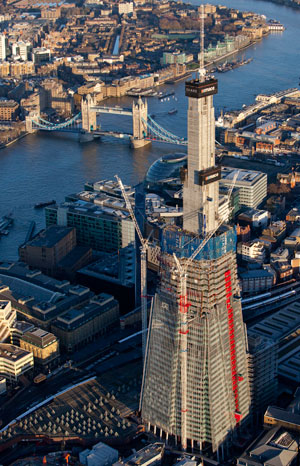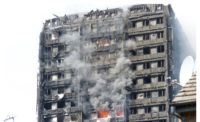Even without the spire that will make London’s Shard the tallest building in Western Europe, its recently topped-out core, reaching 72 floors above ground, already dominates the city. With the structural steelwork frame ending at level 40, concrete columns and post-tension floors will complete the rest of the 310-meter-tall building’s frame next to the River Thames.

Now looming 244 m over the London Bridge railroad hub, the Shard’s stump has become a temporarily unattractive city landmark. But from ground level, the rising curtain wall gives a foretaste of the final building, designed by architect Renzo Piano Building Workshop, Genoa, Italy. Multifaceted glass panels will enclose the building, converging with 60 inward slopes to the spire’s tip, 95 floors up.
Working round the clock, six days a week, main contractor Mace Ltd., London, aims to complete $690 million of shell-and-core work by May 2012. With fit-out design already in hand, tenants should be moving in later that year, adds Bernard Ainsworth, project managing director with co-developer Sellar Design and Development Ltd., London.
Core construction ended on time in December, despite a delayed start, says Gareth Lewis, Mace’s chief operating officer for construction. Hired before the credit crunch as construction manager, Mace had its contract converted to a fixed-price, lump-sum agreement, which caused a delay in the start of sitework. However, top-down construction, using innovative plunge-pile technology, allowed the company to claw back some eight weeks of lost time, he says.
Smooth Progress
Sophisticated equipment was used to accurately place large steel columns along the core walls’ alignment. The columns were inserted into 15-meter-deep cased boreholes in the wet-concrete tops of the piles. They were “astonishingly accurate,” says John Parker, technical director with the Shard’s structural engineer, WSP Cantor Seinuk Ltd., London.
Concrete subcontractor Byrne Bros. Ltd., Teddington, first cast the ground-floor slab, leaving space for the core. Byrne then excavated the basement as the core went up. As soil was excavated, the exposed plunged steel columns supported the core, like the legs of a chair. The core’s lowest level had to be completed before slipforming could go higher than 28 levels above ground, says Parker.
Byrne completed the excavation and then cast the 1.5-m-deep basement ground slab with a continuous 5,500-cu-m pour a year ago. The core rose at a rapid average rate of two meters a day, says Lewis. Fixing the core’s crane to the slipforming equipment, rather than to the completed wall below, was a novel arrangement that boosted progress, he adds.
Impressive Framework
Steelwork subcontractor Severfield-Reeve Structures Ltd., Thirsk, began erecting 12,500 tonnes of the main frame’s steelwork around the same time the basement was being completed. Steel erection ended at level 40 a few weeks before the core’s topping out in December.
Floors up to level 40 are composite, incorporating some 6,500 tonnes of 50-centimeter-deep beams with webs pre-perforated for duct access and reduced weight, says Parker. The main columns are generally 80 cm by 55 cm and made with 12.5-cm-thick steel at the lowest levels. Because apartment and hotel rooms occupy the upper floors, the designers switched the structure from steel to concrete at level 40.
Beams on the upper floors need less electrical and mechanical ductwork than the lower, commercial levels; furthermore, concrete offers more insulation against sound, explains Parker. The post-tensioned concrete floors are 20 cm thick and span between cast-in-place perimeter columns. Using concrete rather than more flexible steel at the upper levels also obviated the need for tuned mass damping, he adds.
Although the distance between perimeter columns reduces to three meters from six meters between the concrete and steel levels, the structure has no massive transfer structures, says Parker. Instead, to transfer loads, perimeter beams between levels 37 and 40 are enlarged to act in concert with the columns, forming a Vierendeel truss, he adds.
Occupied floors of the Shard will reach up to an observatory at level 72. Above that, the equipment rooms will rise to floor 87, with glasswork continuing to the summit. The construction team has started assembling a trial five-tonne module of spire steelwork. “We don’t want to lift individual pieces of steel,” Lewis says, noting that they are working at a higher elevation than workers at any Western European building in history.

